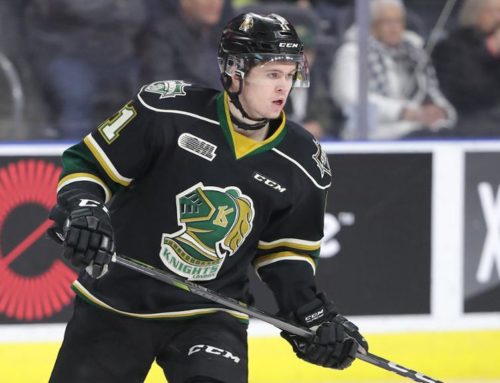December 31-in-31: Winnipeg Jets
Hadi Kalakeche
2020-12-31
Welcome to the December 2020 edition of the DobberProspects 31-in-31 Series! This month, we will be diving into the depth of each organization, looking at their recent graduates, risers, fallers and top 20 prospects.
**
As was discussed in last month’s article, the Jets have fallen out of the playoff picture in the last two years due to roster turmoil, especially on the blueline. What was once their team’s best quality, has turned into their main lacking within the last two offseasons, as they lost Jacob Trouba, Tyler Myers, Dustin Byfuglien, and Ben Chiarot within that time. They also added Neal Pionk, Dmitry Kulikov, Luca Sbisa, and Nathan Beaulieu in return. The Kulikov experiment, as it happens, is already over, as he was released to free agency and picked up by New Jersey; the latter group of blueliners is a massive downgrade from the former, and Winnipeg has yet to recover from such a loss of talent on the back end.
The Jets are now left plugging holes in the cockpit and trying to stay in the air by adding Dylan DeMelo and Derek Forbort to their back end. Paul Stastny’s return to Winnipeg will also be welcomed – the Quebec-born center had been a trade deadline pickup for Winnipeg in 2018, who gave the St. Louis Blues 21-year-old Erik Foley, a 1st round pick (2018, 29th overall, TOR – Rasmus Sandin) and a 4th round pick (2020, 103rd overall, MTL – Jack Smith) for his services. The hockey he played for Winnipeg, however, was well worth the cost, as he flirted with a point per game in the playoffs and helped secure a Conference Finals appearance, in which the brand-new Vegas Golden Knights prevailed after five games.
Paul Stastny scored a pair of goals and added an assist to lead the Jets to a 5-1 victory over the Preds in Game 7.
He's your @GatoradeCanada Performer of the Night! #CoolAsIce pic.twitter.com/GjWdz4PbNS
— Sportsnet (@Sportsnet) May 11, 2018
The Jets’ management then lost Stastny to free agency, and none other than the Vegas Golden Knights acquired his services. Following his two-year tenure in Sin City, the Golden Knights traded him back to Winnipeg at a discount to free up their cap space. The now 34-year-old Stastny will look to recreate his production from 2018 and return Winnipeg to where they were when he was last there. When he will look around, however, many key faces will have been gone since he last sat in that dressing room. Still, Winnipeg has added some extremely promising prospects to their pool and look to build around their current forward core, which still remains one of the top offensive lineups in the NHL. With Hellebuyck in net as well, nothing is out of the question.
**
Graduating Players
David Gustafsson, C
Gustafsson started the 2019-2020 season with Winnipeg, as he impressed in preseason with his strength on his feet, his two-way game, and his stickhandling ability. Within two months, he had his first point, a goal he earned after deking through Erik Karlsson, of all people.
David Gustafsson of the Winnipeg Jets scores his first NHL goal against the San Jose Sharks! #GoJetsGo #NHL #SJSharks #HockeyTribune #Hockey pic.twitter.com/HwA0io88UW
— Tribune Sports (@_TribuneSports) November 28, 2019
After a dozen bouts in a support role, however, it was starting to become clear that Gustafsson did not currently have the foot speed or the cardio to handle 82 games of NHL action. He spent the rest of the season going back and forth between the Jets and their AHL affiliate, never really sticking to the lineup.
The clip above shows how much momentum is lost in Gustafsson’s forward strides – he wastes a lot of energy for very little movement by keeping his upper body straight instead of rotating his torso, and therefore not digging perfectly well into the ice surface to propel himself. He does not utilize his crossovers to gain speed, which is an essential tool to skate both faster and with less predictability. In short, his cardio issue is in fact a disguised skating issue.
However, Gustafsson has shown some slight improvement in his skating during his COVID stint in the Allsvenskan, as well as adapting his game to his strengths; he shows astute offensive and defensive positioning, as well as the ability to read the play a step ahead in order to never be caught flat-footed or in a puck race. He should secure a long-term bottom-six role for Winnipeg as soon as next year, and could eventually reach a level where Winnipeg would feel comfortable having him plug an injury hole in the top-six.
Ville Heinola, LD
Heinola had already shown Jets fans a taste of his game last season, as he played his eight NHL trial games, earned five points, and then was loaned to Luukko in Finland in order to retain an extra year of his entry-level contract.
Ville Heinola puts home his first NHL goal to tie it up for Winnipeg!#GoJetsGo pic.twitter.com/iuGtPQXuMC
— Hockey Daily 365 (@HockeyDaily365) October 9, 2019
In ten fewer games with Luukko this season, he has already doubled his previous year’s point production in the Finnish Liiga, with 14 points through 19 games. Heinola’s understanding of the game offensively, transitional, and defensively will lead him to be trusted in many different situations, from the powerplay where he will display his astounding vision and accurate shot, to the penalty kill where his astute positioning and stick-checking will be useful to Winnipeg. He should be an NHL regular as soon as next season, and Jets fans will love his game.
Sami Niku, LD
Niku’s luck this season has been nothing short of abysmal; after a car accident in September, the 24-year-old Finn injured his groin during a soccer warm-up a couple of weeks before COVID-19 brought the world to a halt. As a result, he only played 35 professional games last season and has yet to see a full NHL season since half of those games were with the Moose.
WHAT A GREAT TIME TO SCORE YOUR FIRST NHL GOAL! SAMI NIKU WILL REMEMBER THIS ONE FOR A LIFETIME! 4-3 JETS! pic.twitter.com/kzJq3fgESC
— Hockey Daily 365 (@HockeyDaily365) April 4, 2018
However, Niku’s number is up, and he will get a better chance than ever to show Winnipeg what he can accomplish with proper ice-time and responsibilities. To become a full-time NHLer, he will need to stay healthy and keep his temper in check, as the blueliner has not made his coaches’ lives easier with trade requests, arguments, and teammate altercations.
Risers
Henri Nikkanen, C
Nikkanen is a player that was injured often in his draft year, and scouts had little to see of his game; his offensive toolbox is extensive, with goalscoring being his main specialty. He can wrist the puck past a goaltender, but can also tip it, slap it, or backhand it efficiently. He has been honing his playmaking and two-way game, and as a result, his production has been improving with every passing year; last season, he was a point-per-game player through 28 games in the Finnish Junior A league, but could not accumulate more than three assists in 27 Liiga games. This season, however, Nikkanen has two goals and five assists through 15 games in the Liiga, with a weak Jukurit team that promotes defense-first hockey.
Henri Nikkanen (WPG) scores his third goal of this wild card series. TPS with a 2-1 lead with 30 seconds left. #NHLJets pic.twitter.com/bmQeuaG63s
— Lassi Alanen (@lassialanen) March 9, 2020
Having been selected in the fourth round in 2019, it is impressive how quickly Nikkanen has adapted to stronger opposition, although his mature frame did assist his transition. If Nikkanen continues putting together a decent season against Finland’s best, he should climb quickly up the Jets’ depth chart.
Jansen Harkins, C
The American-born centerman has gone from being sent down to the ECHL in 2018, to being a decent full-time AHLer in 2019, to splitting time between the NHL and AHL last season while putting up a point per game in the latter. Given his progression curve to date, a full NHL season should be signed, sealed, and delivered for him in 2021.
Jansen Harkins with a top shelf beauty for his 1st playoff goal 🚨pic.twitter.com/0FlYTjMsyF
— Hockey Night in Canada (@hockeynight) August 3, 2020
However, in his 29 games in 2019-2020, he only managed seven points, and Harkins’ career has been marked by developmental inconsistencies. For example, he was a point-per-game player in his draft year at the WHL level and then dropped to 59 points in 67 games the next season, despite a year of physical and technical development. What is certain is that Harkins’ value is growing with every passing year, and he seems primed and ready for a breakout season, especially with a freshly-inked two-year deal to his name. His skating, stickhandling, and playmaking should carry him to a decent NHL career.
Fallers
Simon Lundmark, RD
Lundmark is a right-handed blueliner with adequate defensive instincts and positioning – he is calm and collected in front of his own net, deflecting pucks away with poised stick-checks and pushing players out of the blue paint. His size and skating are assets when his team does not have the puck, and his team has been sheltering him to his strengths. He has only earned 11 minutes per game as of right now, most of which are either defensive zone starts, penalty kill time or minimal second powerplay time. His three points in 40 games indicate a clear lack of offense; his abilities with the puck center around moving play forward and generating offensive zone time with some level of regularity, but nothing stands out about his attacking tools.
Henri Nikkanen (WPG) scores his third goal of this wild card series. TPS with a 2-1 lead with 30 seconds left. #NHLJets pic.twitter.com/bmQeuaG63s
— Lassi Alanen (@lassialanen) March 9, 2020
I believe Lundmark to be a bottom-pair, play-killing defenseman in the making, but such a player cannot be worth a mid-second-round pick; many scouts had him in the mid-eighties, with the most generous estimates placing him in the seventies. Lundmark has yet to prove Winnipeg right in jumping the gun to pick him, and Nick Robertson’s selection just two picks later does not help their case for this pick being a smart one.
Logan Stanley, LD
Stanley was Winnipeg’s 18th overall pick just four drafts ago, in 2016. Why? Well, he is 6-7, 220 pounds, and teams love that. Other than his size, however, Stanley had shown nothing truly impressive in his Draft year, with 17 points in 64 games and an overall sluggish pace to his game in a sport that is speeding up exponentially. After an impressive final year in Kitchener with 42 points, he arrived in Manitoba and scored 22 points in 73 games as a rookie. He seemed on the rise, but the 2019-2020 season saw him play only 44 games due to minor injuries, in which he tallied ten points.
Players like Logan Stanley rarely turn into proper top-twenty talent, since spending three years playing against Juniors as a 6-7 shutdown defender gives a major advantage to the player that disappears the moment they reach professional hockey. You might get the odd Zdeno Chara or Colton Parayko type, but Stanley is more of a Hal Gill, in a league in which Hal Gills are losing their place. With five players drafted after Stanley in the first round having already played 80 games, he will have to show that he is simply developing at a slower pace than his peers. Hopefully, he builds around his current skillset and elbows his way into an NHL lineup, but the odds are dimming.
**
Organizational Depth Chart (Combination of NHL readiness and upside)
| Left Wing | Center | Right Wing |
| Kristian Vesalainen | Cole Perfetti | Daniel Torgersson |
| Skyler McKenzie | Mason Appleton | Jansen Harkins |
| CJ Suess | David Gustafsson | Andrei Chibisov |
| Joona Luoto | Henri Nikkanen | Michael Spacek |
| Nathan Smith | JC Lipon | |
| Harrison Blaisdell | ||
| Santeri Virtanen | ||
| Left Defense | Right Defense |
| Ville Heinola | Leon Gawanke |
| Sami Niku | Johnathan Kovacevic |
| Anton Johannesson | Luke Green |
| Declan Chisholm | Simon Lundmark |
| Dylan Samberg | Jack Glover |
| Logan Stanley | Nelson Hogier |
| Goaltenders |
| Arvid Holm |
| Eric Comrie |
| Jared Moe |
| Mikhail Berdin |
**
Top 20 Fantasy Prospects
This section is intended to paint a picture of the Winnipeg Jets’ prospects whose current trajectory projects them making the most positive fantasy impact at the time that they reach the NHL. Arrival date and NHL certainty have been taken into consideration. However, a player’s potential upside is the most important factor in determining this list.
- Cole Perfetti, C/W
- Ville Heinola, LHD
- Sami Niku, LHD
- Kristian Vesalainen, LW
- Anton Johannesson, LHD
- Mason Appleton, C
- David Gustafsson, C
- Jansen Harkins, C
- Daniel Torgersson, RW
- Henri Nikkanen, C
- Michael Spacek, RW
- Declan Chisholm, LHD
- Arvid Holm, G
- Nathan Smith, C
- Pavel Kraskovsky, C
- Leon Gawanke, RHD
- Skyler McKenzie, LW
- Dylan Samberg, LHD
- Jared Moe, G
- Santeri Virtanen, C
**
Find me on Twitter @HadiK_Scouting






